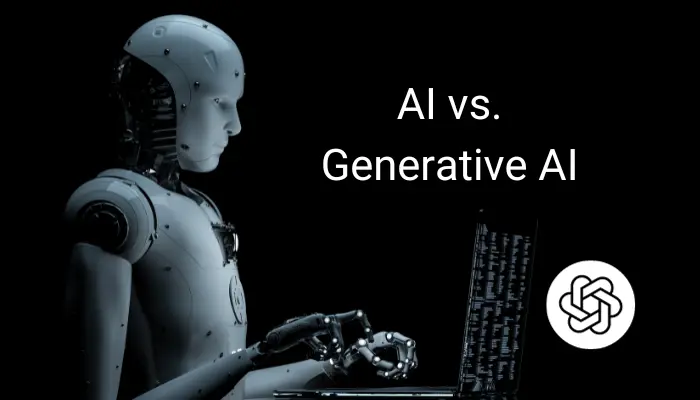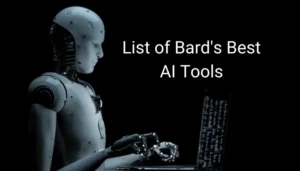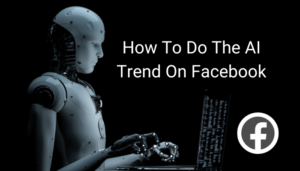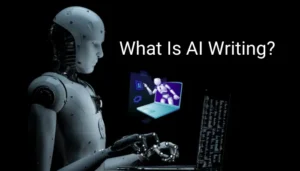In the present technologically driven world, Artificial Intelligence (AI) has transformed into a revolutionary factor, impacting all aspects of life. From empowering virtual assistants to optimizing business processes, AI has made an impression. However, a new competitor is on the scene: generative AI. The debate between “AI vs. Generative AI” is growing in popularity as these technologies continue to develop.
In this ever-changing environment knowing their differences becomes important to comprehend their respective role and impact.
This blog post focuses on the distinctions of classic AI in comparison to Generative AI with a focus on their capabilities, usage scenarios and the potential implications for the future. The contrast to “AI vs. Generative AI” highlights the subtle distinctions between these two technologies, and provides an understanding of their distinct capabilities in the rapidly
What Is Generative AI vs. AI?
We’ll further clarify the distinctions in this section, “What Is Generative AI vs. AI?” In this segment, we’ll dissect Generative AI and traditional AI to unravel the intricacies of “AI vs. Generative AI.”
1. Generative AI
Generative AI is an area of AI that is focused on creating new content in a way that is autonomously. In contrast to traditional AI which is based largely on pre-programmed rules Generative AI displays a degree of independence and creativity when creating content. This can range from creating images and text, to composing music compositions. Examples that use Generative AI are the OpenAI GPT model, that are able to produce coherent and relevant text based on inputs given.
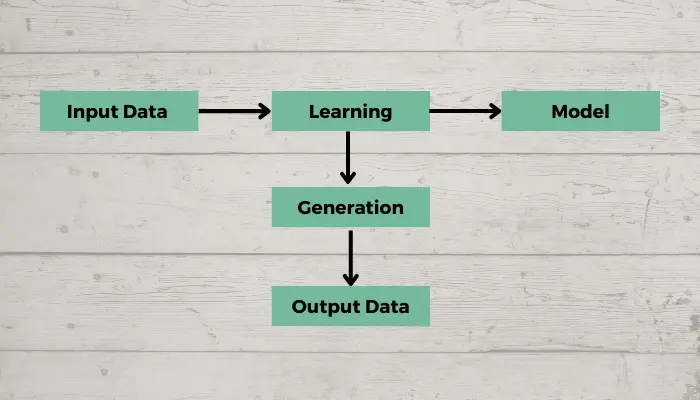
2. AI (Artificial Intelligence)
Artificial Intelligence, or AI, is the field that focuses on creating computer systems that can do tasks that usually need human intelligence. This field covers a range of systems, from simple rule-based ones to complex machine learning algorithms.
Key Characteristics of AI and Generative AI
| Characteristic | AI | Generative AI |
|---|---|---|
| Learning Approach | Supervised learning from labeled data | Unsupervised learning from unlabeled data |
| Autonomy | Task-specific within defined parameters | Creative autonomy in generating new content |
| Data Processing | Relies on structured data | Adaptable to unstructured data |
| Task Efficiency | Precise and efficient for specific tasks | Adaptable, excels in creative and diverse |
Key Differences Between AI and Generative AI
Let’s now delve deeper into the details of Artificial Intelligence (AI). By examining the distinctions between traditional AI and Generative AI, we can explore the complexities of this field.
1. What is the Difference Between AI and Generative AI?
The fundamental difference lies in the capacity to generate new content. Traditional AI is often task-specific, excelling in tasks it has been trained for, such as classifying images or translating languages. In contrast, Generative AI can autonomously create content without being explicitly programmed for a specific task.Read more about: Is ChatGPT Generative AI?
2. Data Processing Capabilities:
AI relies on structured data and follows predefined algorithms. Generative AI, however, can work with unstructured data, making it more adaptable to creative tasks like generating art or composing music.
3. Learning and Adaptation Mechanisms:
Traditional AI usually is based on supervised learning in which it is taught from data that is labeled. Generative AI however, on the other is often based on unsupervised learning that allows it to discover patterns and patterns from unlabeled data which allows for a more imaginative and adaptable method. Find out more: How do you apply AI in your work?
4. Autonomy and Creativity in Generating Content:
While AI operates within defined parameters, Generative AI has a degree of autonomy, allowing it to produce content that goes beyond its initial training. This autonomy is what enables Generative AI to create realistic and contextually relevant content, whether it’s writing a story or composing a piece of music.

Use Cases: Where AI and Generative AI Excel
AI can be utilized in many industries like finance, healthcare manufacturing and finance. For instance AI-powered diagnostic tools are able to look at medical images and detect irregularities, which can improve the effectiveness of healthcare experts. Contrarily, Generative AI shines in areas of creativity. Writers and artists utilize Generative AI to spark fresh ideas. It also contributes to the creation of characters and virtual worlds in the gaming business.
| Use Case | AI | Generative AI |
|---|---|---|
| Healthcare Diagnosis | Analyzing medical images for anomalies | Assisting in creative tasks like generating art |
| Finance | Data analysis and fraud detection | Creating innovative solutions or financial models |
| Manufacturing | Process optimization and automation | Designing new product concepts or prototypes |
| Content Creation | Copywriting and social media automation | Generating original content, like stories or music |
Advantages and Limitations
Let’s explore the distinct advantages and limitations that set traditional AI and its creative counterpart, Generative AI, apart.
Advantages of Traditional AI:
Traditional AI excels in tasks that require precision and efficiency. Its rule-based approach ensures accuracy in specific domains, such as data analysis and problem-solving.
Advantages of Generative AI:
Generative AI introduces a level of creativity and adaptability. It can produce novel content, making it valuable in scenarios where innovation and originality are paramount.
Limitations:
Traditional AI may struggle with tasks outside its predefined scope. For instance, an image recognition AI may falter if presented with a scenario it hasn’t been trained for. Generative AI, while creative, may sometimes produce content that lacks coherence or relevance.
Generative AI vs. AI: Which is Right for Your Needs?
In making a decision whether to go with Generative AI and traditional AI It is important to take into consideration your particular requirements. If you require a software to analyze data as well as process optimization or for specific tasks conventional AI might be the better option. However when your objective is creative thinking, creation of content or solving problems with a new approach, Generative AI might be an appropriate choice..
The Future of AI and Generative AI
The future is expected to bring continued advances in both AI as well as Generative AI. Conventional AI is likely to become sophisticated and efficient in tasks-oriented applications and Generative AI could evolve to create more sophisticated and personalised content. As these technologies develop in their development, ethical considerations concerning their application and impact will play an important part in shaping the future of these technologies. Read more: Generative AI vs predictive AI.
Conclusion:
In the world of “AI vs. Generative AI,” each one has its distinct strengths and uses. AI with its precise task-specific accuracy is essential in a variety of sectors, as it ensures efficiency and optimality. Generative AI provides a new outlook because it is flexible and creative that means it is able to create new and innovative content.
Have you ever used AI as well as Generative AI in your projects? Join the discussion via social networks to keep up-to-date on the latest developments in AI.

